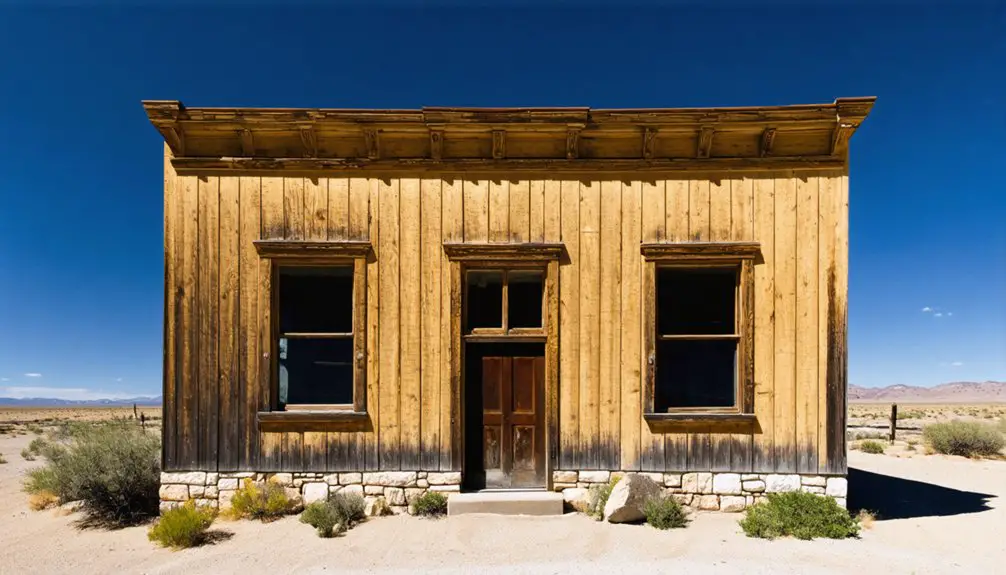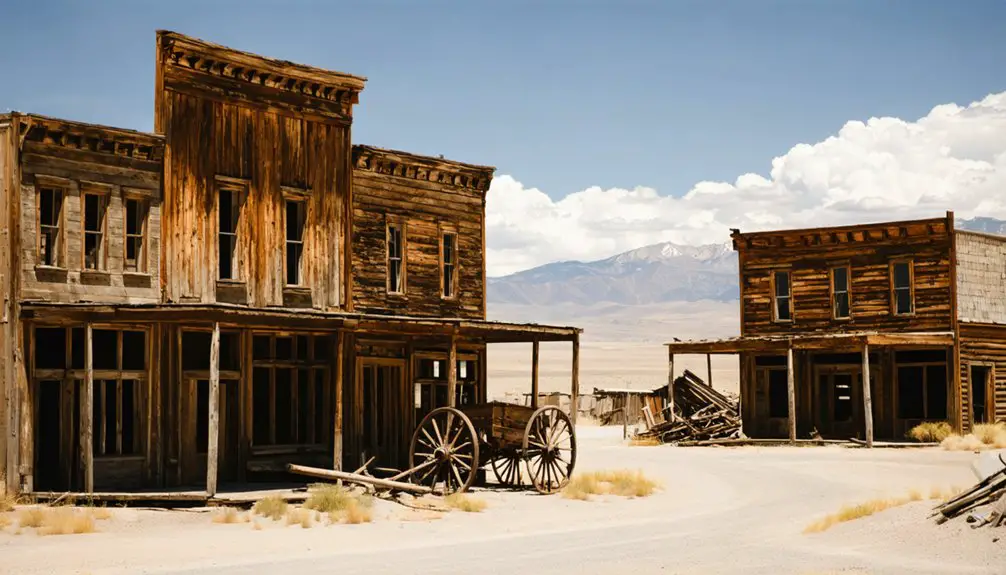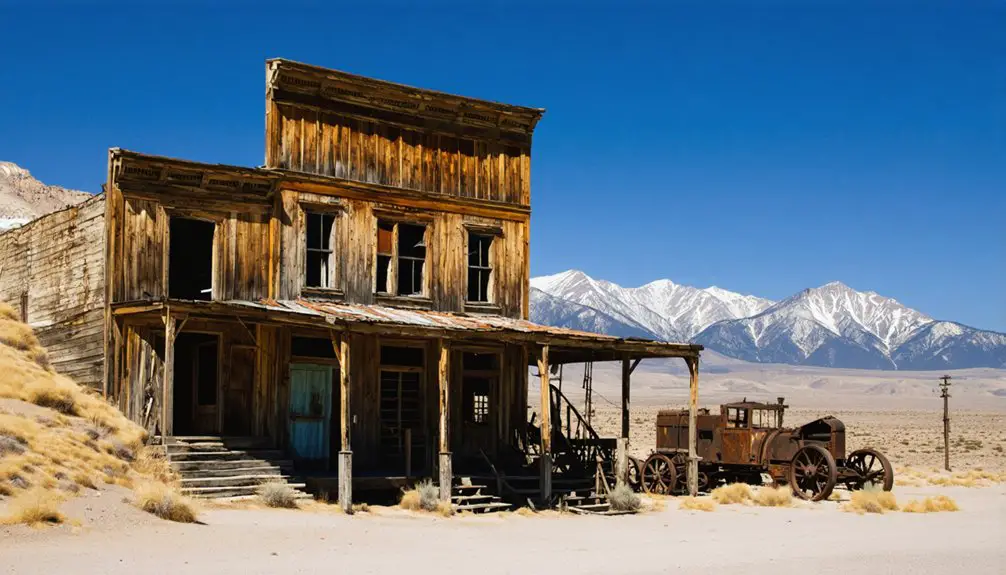You’ll find Pioche perched in southeastern Nevada, where silver’s discovery in 1864 sparked one of America’s deadliest mining towns. During its 1870s peak, the town witnessed 72 violent deaths before recording its first natural one, while producing over $20 million in silver ore. Today, you can explore its preserved landmarks, including the Million Dollar Courthouse, Thompson’s Opera House, and the innovative aerial tramway system that once revolutionized ore transport. This ghost town’s dramatic past holds countless untold stories.
Key Takeaways
- Pioche became Nevada’s richest silver mining town in the 1870s, producing $20 million in ore and hosting over 7,000 residents.
- Known as the West’s deadliest town, Pioche recorded 72 violent deaths before its first natural death.
- Historic landmarks still stand today, including the 1873 Thompson Opera House and 1872 Million Dollar Courthouse.
- The town declined after 1872 due to decreasing silver yields, though preservation efforts maintain its Wild West heritage.
- The iconic Pioche Aerial Tramway, built in the 1920s, revolutionized ore transportation and remains a visible historic structure.
The Birth of a Silver Mining Town
When Mormon missionary William Hamblin followed the guidance of local Paiute Indians to discover silver ore near present-day Pioche in 1864, he sparked what would become one of Nevada’s most significant mining developments.
Initially, mining techniques remained basic and progress was slow, but by 1869, you’d have witnessed a dramatic transformation as major mines began operations in the newly established town.
The rich silver veins, found in the Cambrian Prospect Mountain quartzite and Highland Peak Limestone formations, quickly attracted miners and entrepreneurs.
The town layout emerged around these profitable claims, with the mining district first organized as Ely before becoming known as the Pioche district.
The area proved incredibly lucrative, with over five million dollars in ore extracted by 1872.
By 1871, the booming mining town had grown to include 6,000 residents and became the county seat of Lincoln County.
Blood in the Streets: A Legacy of Violence
During the early 1870s, Pioche earned its reputation as the deadliest town in the American West, with violence claiming more lives than natural causes.
You’ll find that a staggering 72 people met violent deaths before anyone succumbed to natural causes, with Boot Hill Cemetery holding over 100 murder victims in marked and unmarked graves.
The violent legacies stemmed from corrupt law enforcement, who pocketed $40,000 annually in bribes, and fierce disputes over mining claims.
Notorious outlaws and gunfighters, drawn by the $20 daily pay for claim protection, turned the streets into battlegrounds.
The town’s remote location meant most killings went unpunished, fostering a culture of lawlessness that surpassed even Tombstone and Bodie.
Even today, Boot Hill’s weathered headstones tell tales of ambushes, shootouts, and deadly feuds that defined Pioche’s bloodiest era.
Nearly 60% of Nevada’s homicides occurred in and around Pioche during 1871-1872, making it the state’s most dangerous mining settlement.
The violence peaked in 1872 when the town reached its peak mining activity, creating intense competition for valuable silver claims.
Mining Operations and Economic Growth
You’ll find that silver production in Pioche reached remarkable heights in the early 1870s, with over $600,000 worth of ore extracted and shipped to regional mills as mining companies like Raymond & Ely and Meadow Valley engaged in fierce competition for claims and resources.
The mining camp’s reputation for lawlessness and violence was notorious, with reports indicating that 72 people died from gunfights and killings before the first natural death occurred.
The mining landscape transformed dramatically when the Pioche Consolidated Mining Company invested more than $1 million in development, employing 800 men with monthly payrolls exceeding $50,000. A new smelting plant began converting ore into bullion in October 1891.
The introduction of the aerial tramway in the 1920s revolutionized ore transport from Treasure Hill to Godbe’s Mill, slashing costs to just six cents per ton while maximizing efficiency.
Silver Production Peaks
After the initial silver discovery in 1864, Pioche’s mining operations expanded dramatically between 1870-1875, with the Raymond and Ely mines alone producing an astounding $20 million in silver ore.
You’ll find that silver mining transformed Pioche into southern Nevada’s most significant settlement, rivaling even the Comstock district. Like the first silver discovery in 1858 that launched Nevada’s reputation as the Silver State, Pioche’s economic legacy of this peak period shaped the town’s infrastructure and population growth. John H. Ely and William H. Raymond established a rich claim in 1869 that proved immensely profitable for the region.
- By 1872, the district’s mines had yielded over $5 million in silver ore
- François Pioche’s 1868 smelter kicked off industrial-scale processing
- The Pioche Consolidated Mining merger in 1890 streamlined operations through advanced milling facilities
The peak production years between 1870-1930 saw millions in silver extraction, supported by extensive railway systems, innovative tramways, and multiple mill expansions that kept Pioche at the forefront of Nevada’s mining industry.
Mining Company Power Struggles
The landmark 1890 merger of Raymond & Ely, Meadow Valley, and Yuba mines into the Pioche Consolidated Mining & Reduction Company marked a transformative shift in southern Nevada’s mining landscape.
Through corporate consolidation orchestrated by William S. Godbe, the company gained unprecedented control over the region’s mining operations, employing over 800 workers and investing more than $1 million in development.
You’ll find that this consolidation of power fundamentally altered labor relations in Pioche. The company’s $50,000 monthly payroll sustained the local workforce while its grip on critical infrastructure – including eighteen miles of railroad and smelting facilities – effectively squeezed out independent operators. The introduction of flotation processes in 1924 revolutionized the company’s ability to process previously unprofitable zinc-lead sulfide ores.
This corporate dominance reshaped the town’s economic structure, driving population growth from 750 to over 2,000 residents and spurring widespread commercial development throughout the area.
Aerial Tramway Transport System
During the 1920s and 1930s, Pioche’s innovative aerial tramway system revolutionized ore transportation from Treasure Hill mines to the Godbe Mill below. This cutting-edge aerial technology operated primarily through gravity power, with loaded ore buckets pulling empty ones uphill, supplemented by a small 5-horsepower motor when needed. The historic mining structure began its operation in 1891, making it a pioneering development in Nevada’s mining industry.
You’ll find this efficient ore transport system slashed delivery costs to just six cents per ton by 1928, while eliminating reliance on slower horse-drawn carts.
- The tramway’s route soared over Boot Hill Cemetery, following the dramatic terrain changes between the mines and mill.
- Its mechanical ingenuity included a massive cast flywheel at the loading bin, showcasing industrial engineering prowess.
- The system enabled continuous ore movement, supporting expansions like the 1929 flotation concentrator upgrade at Godbe Mill.
Today, it stands as Nevada’s only remaining aerial tramway structure, a monument to mining innovation.
Historic Buildings That Stand Today

You’ll find some of Nevada’s most significant frontier-era buildings still standing in Pioche, including the wooden Brown/Thompson Opera House from 1873 and the imposing Mission-style schoolhouse built in 1909.
The Opera House, which served as the town’s cultural heart during the silver boom, retains its classic revival and pioneer board architectural style after being fully restored to serve modern visitors.
Both landmarks represent the town’s evolution from a rough mining camp to an established community, with the Opera House hosting everything from theatrical productions to community dances while the schoolhouse educated local children for nearly a century.
Landmark Public Architecture Endures
Standing as proud sentinels of Pioche’s vibrant past, several landmark buildings continue to define this historic Nevada mining town’s architectural legacy.
You’ll discover architectural significance in every corner, from the 1937 Art Deco Gem Theater with its iconic neon marquee to the 1872 Million Dollar Courthouse, which took nearly a century to pay off.
The landmark preservation efforts have protected these treasures, earning many spots on the National Register of Historic Places.
- Thompson’s Opera House (1873) showcases classic revival style and still hosts special events after full restoration
- The Mormon-built Town Hall (1936-37) stands as proof of community spirit and craftsmanship
- The Mission Revival-style Pioche School (1909) remains a striking example of early 20th-century educational architecture
Pioneer-Era Entertainment Venues
While mining fortunes rose and fell in 1870s Pioche, two historic entertainment venues emerged that would shape the town’s cultural legacy for generations.
Brown’s Hall, later renamed Thompson’s Opera House, opened in 1873 as a two-story gathering space where the Odd Fellows Ball marked the height of frontier elegance. Theater history came alive with performances of classics like *Pygmalion and Galatea*, while community gatherings filled the hall with lectures and variety shows.
In 1937, the Art Deco-styled Gem Theater revolutionized local entertainment, bringing movies and wartime newsreels to Lincoln County.
Though the Gem stands vacant since 2002’s roof damage, preservation efforts continue.
Today, Thompson’s Opera House still hosts occasional performances and houses the visitor center, preserving a tangible link to Pioche’s vibrant cultural past.
Notable Events That Shaped Pioche
During its turbulent frontier days, Pioche earned a reputation as one of Nevada’s deadliest mining towns, where violence and disaster shaped its identity. In 1871-72, this remote settlement witnessed 60% of Nevada’s homicides, as cultural conflicts erupted over mining claims.
Miners turned Pioche into Nevada’s bloodiest boomtown, where greed and gunfire decided the fate of silver claims.
You’ll find evidence of this deadly era in Boot Hill Cemetery, where 72 men met violent ends before the town recorded its first natural death.
- A catastrophic fire and powder explosion in 1871 killed 13 people, injured 47, and left most residents homeless.
- Environmental challenges struck hard, with devastating floods in 1873 dropping 3.4 inches of rain in just two hours.
- The town’s lawlessness peaked when mine owners hired gunfighters at $20 daily to protect their claims, while the sheriff’s office collected $40,000 annually in bribes.
From Boom to Bust: The Population Story

As prospectors discovered rich silver deposits in 1864, Pioche’s population story began with a false start, as Indian raids forced an initial abandonment until 1868.
When François Pioche purchased the town in 1869, the population dynamics shifted dramatically. You’d have witnessed an explosion of growth as the town swelled to over 7,000 residents by 1871, driven by impressive economic fluctuations in silver production – from $600,000 in 1870 to $5.5 million by 1872.
Despite rampant violence claiming 72 lives before the first natural death, fortune-seekers kept arriving.
But the boom wouldn’t last. After 1872, declining mine yields, devastating fires, and floods triggered a mass exodus. By 1900, you’d have found Pioche nearly deserted, though it maintained its status as county seat, transforming from a bustling boomtown into a quiet historic community.
Preserving the Wild West Heritage
The legacy of Pioche’s tumultuous past lives on through dedicated preservation efforts that began in the mid-20th century.
You’ll find heritage preservation at work in landmark buildings like the Brown/Thompson Opera House, now serving as the Tourist Information Center, and the Orr Garage, which evolved from a blacksmith shop to an auto repair facility.
Cultural storytelling reaches its peak at Boot Hill Cemetery, where epitaphs narrate tales of the town’s violent frontier days.
- Experience guided tours through the Million Dollar Courthouse and historic Pioche Aerial Tramway
- Explore preserved structures that showcase adaptive reuse while maintaining architectural integrity
- Discover authentic Wild West stories through interpretive displays and community-led events
The local community’s commitment to preserving these historical treasures guarantees you’ll connect with Nevada’s raw, untamed mining heritage firsthand.
Frequently Asked Questions
What Is the Current Year-Round Population of Pioche?
You’ll find today’s current demographics show approximately 1,223 year-round residents, reflecting the historical significance of this county seat’s modest growth from its 2020 census count of 933 people.
Are There Any Active Mines Still Operating Near Pioche Today?
Despite Pioche’s rich mining history and favorable local geology, you won’t find active mines operating there today. The area’s historic mines have ceased operations, with most sites under environmental monitoring and remediation.
What Is the Best Time of Year to Visit Pioche?
Like a desert flower in full bloom, you’ll find your sweet spot visiting from late spring through fall, when you’ll enjoy the best weather and seasonal events without winter’s harsh grip.
Can Visitors Explore the Abandoned Mines Around Pioche?
You can’t explore the abandoned mines, as they’re strictly off-limits and dangerous. While you’ll enjoy Pioche’s ghost town history, the mines are secured, fenced, and protected for your safety.
Are There Any Hotels or Accommodations Available in Pioche?
You’ll find several hotel options in town, including the historic Overland Hotel & Saloon with 13 rooms, the budget-friendly Motherlode Motel, plus RV parks and vacation rentals for more independent stays.
References
- https://en.wikipedia.org/wiki/Pioche
- https://www.nvexpeditions.com/lincoln/pioche.php
- https://www.islands.com/1730058/pioche-nevada-old-school-town-stepping-onto-hollywood-western-movie-set-lively/
- https://travelnevada.com/cities/pioche/
- https://www.legendsofamerica.com/pioche-nevada/
- https://westernmininghistory.com/towns/nevada/pioche/
- https://www.youtube.com/watch?v=W2K0jgP14Yw
- https://shpo.nv.gov/nevadas-historical-markers/historical-markers/pioche
- https://en.wikipedia.org/wiki/Silver_mining_in_Nevada
- https://piochenevada.com/history/



